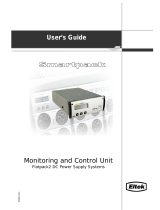
•Voltage Hysteresis—The voltage range where the alarm can clear or activate. For
example, if the low voltage alarm activates at 43.00 V, having a voltage hysteresis of
0.50 V means it clears when the voltage reaches 43.50 V. This applies only to Voltage
Alarms (7.5.5.2).
•Time Hysteresis—The amount of time in seconds that the condition has to be true
before the alarm is activated. In the example above, if the value of time hysteresis is 5
seconds, the voltage must be below 43.00 V for at least 5 seconds before the alarm is
activated. Similarly, to clear the alarm, the voltage must be above 43.50 V for 5
seconds.
4. Select the alarm tone.
5. To set the duration that alarms remain cutoff when the alarm cutoff (ALCO) is activated,
select Enable ALCO Duration and specify the number of minutes for the cutoff.
6. To disable the audible alerts for alarms with the alarm cutoff enabled, select Silence Buzzer.
7. To revert the relay status to the normal state by activating the alarm cutoff, select Revert
Relays.
8. To stop sending email when alerts are triggered, select Stop Sending Email.
9. To stop sending SNMP traps with cutoff alarms when alerts are triggered, select Stop
Sending SNMP Traps.
New alarms triggered after the alarm cutoff is activated will send SNMP traps.
10. Click Next.
Identifying where alarm and trap messages are
sent
Configure the email address and SNMP trap destination where alarms are recorded.
Find Christie SNMP information and MIBs at www.christiedigital.com/SNMP.
1. Log in to the Remote Power 48V web interface (on page 1).
2. Select Communications > Event Notification Destination.
3. Click Add New Destination.
4. Type a name for the destination.
5. Select whether the notification should be sent through email or recorded in the SNMP trap.
6. (Optional) To configure the SNMP trap destination, select the connection type.
• Select Broadcast if the Remote Power 48V is located in the same segment as the
network management station (NMS). An IP Address is not required. Broadcast cannot
be used as master.
• Select IP Address if the value is known for NMS. This is the recommended setup
selection for SNMP destination configuration.
• Select Host Name if the NMS has a fully qualified domain name that can be resolved
by a DNS server.
7. (Optional) Configure the SMTP setting for email communication.
a) Type the SMTP IP address.
b) In the From Address field, type the email address the notification email will be sent
from.
Monitoring the Remote Power 48V
Monitoring the Remote Power 48V Instruction Sheet 3
020-000850-01 Rev. 1 (09-2016)
Copyright © 2016 Christie Digital Systems USA Inc. All rights reserved.







